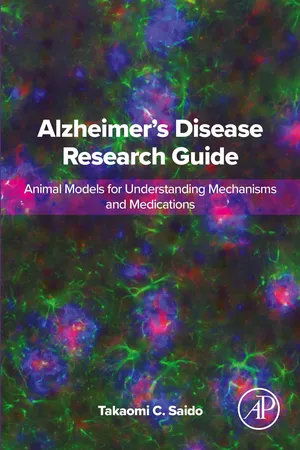
Alzheimer's Disease Research Guide
Animal Models for Understanding Mechanisms and Medications
- 282 pages
- English
- PDF
- Only available on web
Alzheimer's Disease Research Guide
Animal Models for Understanding Mechanisms and Medications
About This Book
Alzheimer's Disease Research Guide: Animal Models for Understanding Mechanisms and Medications provides researchers with a comprehensive guide, detailing every aspect of Alzheimer's Disease research, including chapters on neuroinflammation, immunotherapy, biomarkers, and animal modeling. This book begins with historical perspectives of both pathological chronology and pathological biochemistry in relation to Alzheimer's disease. Other chapters review Amyloidogenic AB and Non-Amyloidogenic tau and Metabolism of AB major components to the research and understanding of Alzheimer's research. The book concludes with specific treatment chapters including how to develop safe, effective, and inexpensive medications and the application of genome editing to the treatment of Familial Alzheimer's Disease.Written by world renowned expert in Alzheimer's research, this book is a valuable resource for all researchers.
- Reviews why familial Alzheimer's disease is vital to understanding sporadic Alzheimer's disease
- Describes the latest "game changer" animal models of Alzheimer's disease and frontotemporal dementia in detail
- Explains how various Alzheimer's disease medications have failed clinical trials
- Discusses pros and cons of therapeutic antibodies, lecanemab and donanemab, that were recently found to be effective in recent clinical trials
- Details the application of genome editing as a treatment for familial Alzheimer's disease
- Proposes publishing " Journal of Negative Data " for the days of generative AI-assisted publication, AI being unable to distinguish between reproducible and unreproducible data, particularly important in Alzheimer's research
Frequently asked questions
Information
Table of contents
- Front Cover
- Alzheimer’s Disease Research Guide: Animal Models for Understanding Mechanisms and Medications
- Copyright
- Dedication
- Contents
- Preface
- About the author
- Abbreviations
- Chapter 1: Introduction: Collaboration and competition together to maximize the velocity of research and development
- Chapter 2: Pathological chronology and pathological biochemistry: The beginning of the beginning
- Chapter 3: Human genetics: Establishment of cause-and-effect relationships
- Chapter 4: Two major culprits: Amyloidogenic Aβ and non-amyloidogenic tau
- Chapter 5: Exact relationship between Aβ40 and Aβ42: An overlooked discovery by Jungsu Kim and colleagues
- Chapter 6: Metabolism of Aβ: Catabolic and glymphatic systems
- Chapter 7: Biology of time: The temporal distance between cause and effect
- Chapter 8: First-generation animal models of Aβ amyoloidosis: Pros and cons of the overexpression paradigm
- Chapter 9: Creation of single App knock-in mouse models and of single MAPT knock-in models: Demonstration of Aβ-tau axis
- Chapter 10: Applications of App and MAPT knock-in mice to understanding disease mechanisms
- Chapter 11: Neuroinflammation: Microgliosis and astrocytosis in the days of microscopic omics
- Chapter 12: Central and peripheral nervous system, immune systems and digestive system: AD as a systemic disorder
- Chapter 13: Failure of more than 400 candidate medications in clinical trials before 2020
- Chapter 14: Therapeutic antibodies as a Wright Brothers' airplane: Clinical proof-of-concept
- Chapter 15: Biomarkers for presymptomatic diagnosis and prognosis
- Chapter 16: Targeting somatostatin receptor heterodimer for effective and economically viable medications without side ef ...
- Chapter 17: Application of genome editing to the treatment of familial AD
- Chapter 18: Identifying significant and insignificant publications: Prelude for Chapter 19
- Chapter 19: Journal of Negative Data for the days of generative AI-assisted publication
- Chapter 20: Conclusions: Let's make the world ADless!
- Eulogy to the late Yasuo Ihara
- Postscript
- Index
- Back Cover